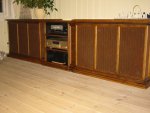The sheet also include english, and I know that it say: not to use water based glue. They recommend contact glue, but as you know one mistake with that, and "good night".Originally Posted by frank23
After a talk with the importer they said "ok". They had never been thinking about using wood glue on both sides, let it dry, and melt it with a hot iron.
Rolf




 Reply With Quote
Reply With Quote

 And now I am oiling and sanding, oiling and sanding x many times ----> a real job. I will finish with a wax polish.
And now I am oiling and sanding, oiling and sanding x many times ----> a real job. I will finish with a wax polish.






